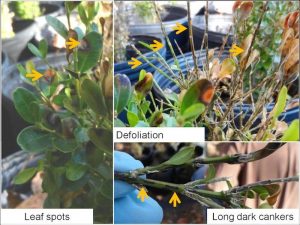Avoid Spreading Boxwood Blight This Holiday
Compiled and edited by Ed Olsen, Extension Agent from various VCE publications
Virginia Cooperative Extension is once again cautioning the public to take measures to avoid spreading the devastating boxwood blight when decorating for the holidays this year. Do you know that boxwood greeneries and decorations could carry the boxwood blight pathogen to your property, destroying precious boxwood plantings that your family has had for generations and threatening those of your neighbors?
Researchers say that boxwood blight could threaten the plants in the same way that the chestnut blight destroyed trees in the 1930s. “The boxwood is not just a plant. It’s part of Virginia’s cultural heritage,” said Chuanxue Hong, Extension specialist in ornamental horticulture at the Hampton Roads Agricultural Research and Extension Center. Boxwoods are the mainstays of landscapes in many historical sites across the commonwealth and an important nursery crop. The wholesale market value for boxwood nursery production is $103 million annually.
In order to help prevent widespread destruction of boxwoods, researchers are asking the public take precautions when using plant cuttings, pruning existing plants, and maintaining plants in household and historical landscapes.

The three main symptoms of boxwood blight: leaf spots, black streaking on stems and defoliation; Photo Credit: N. Dart
Boxwood blight is caused by a fungal pathogen that renders the emerald green leaves brown and dry. The fungus can rapidly defoliate boxwood plants, leading to plant death, making the plants unsuitable for commercial sale, and wiping out ornamental landscapes. The disease spreads primarily by infected plant materials and infested soil from infected plants. This pathogen produces sticky spores that attach to plant containers, tools, vehicles, shoes, clothes and even animals such as dogs and deer. Avoiding visits to infested sites, purchasing and using noninfected plant materials, and practicing strict sanitation methods are crucial to prevent the spread of the disease.
The following simple steps are recommended to mitigate the spread of boxwood blight through holiday clippings:
- When boxwood plants or cuttings are purchased, ask the retailer if the greenery comes from a supplier in the Boxwood Blight Cleanliness Program. Growers in this program adhere to current best management practices.
- Inspect any newly purchased boxwood greenery for symptoms of the disease, including leaf spots, leaf browning, black streaks on stems, and leaf drop. Any greenery that has these symptoms should be double-bagged and discarded in the landfill. Do not compost infected greenery.
- When the holiday season is over, all greenery decorations need to be disposed of properly — double bag them immediately and then throw in trash to be taken to the landfill without delay to avoid any unnecessary complications.
- Use 70 percent alcohol or Lysol Spray Brand III with 58 percent alcohol to sanitize everything that has been in contact with the greeneries and decorations. Consumers are reminded to read and follow all label directions when using these products.
Henrico residents can submit plant samples manifesting symptoms of box blight to the Henrico Extension Office for diagnosis and control recommendations.



Which of the local hardware or feed stores carry either the 70% alcohol or the Lysol spray Brand III with 58% alcohol?
You should easily be able to located the Lysol spray brand III at grocery or drug stores. It is the blue can of Lysol, not the yellow.